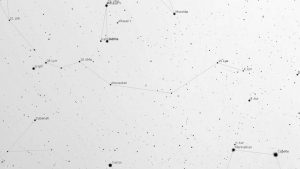| Meaning: | The Lynx | Print out the star map from Sky and Telescope
Things to look for: Messier objects: Note: [x.x] indicates visual magnitude |
|
| Pronunciation: | links | ||
| Associated Asterisms: | None | ||
| % of the sky: | 1.32 | ||
| Visible Stars: | 31 stars brighter than magnitude 5.5 |


The final (almost) circumpolar constellation visible to the UK covered in this journey round the sky is The Lynx. It is surrounded by Auriga, Camelopardalis, Cancer, Gemini, Leo Minor and Ursa Major. The constellation was originally proposed by Johannes Hevelius back in 1690 and is amongst the seven that he proposed in his stellar catalog that survive to this day. One star previously within the bounds of the Lynx was 41 Lyn but its proper motion has carried it to the east into Ursa Major. This has occurred in quite a short period since Flamsteed numbered the stars in the constellation in the early eighteenth century.


The Lynx snakes up between Ursa Major and Auriga in a rough zigzaging line between Regulus in Leo and Mirfak in Perseus. It was named Lynx because of its faintness and acted as a challenge to stargazers to try and see it. Perhaps only the lynx-eyed, optically blessed would be able to recognize it. Johannes Hevelius also used the name Tigris (Tiger) in his catalog but his atlas only used the Lynx. John Flamsteed adopted the constellation in his 1712 catalog and in the later version.

There are no Messier objects within the boundaries of the constellation but there is one New General Catalog object that is worthy of note. NGC2419 is a globular cluster further out than others surrounding the Milky Way, about 80% further out than most and rivaling the Megallanic Clouds for distance. It is known as the ‘Intergalactic Wanderer’ and is located 7° North of Castor in Gemini.

